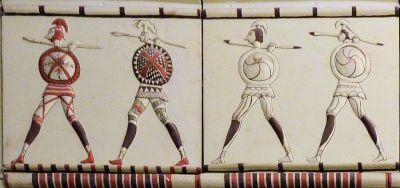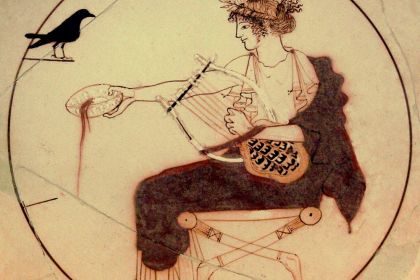Music Theory
Classic examples of the Phrygian mode through the music eras

Phrygian Soldiers at Pararli
Music Periods: Renaissance, Baroque, Classical, Romantic, 20st Century Classical, 21st Century Classical
Musical Mode: Phrygian Mode
From Middle Ages to modernity, Western music has been largely based on diatonic scales that organize seven notes into harmonic systems allowing the composition of melodies and chord progressions.
Most listeners would be familiar with the major and minor scales which are widely used in classical and popular music, although composers work with many other musical modes such as Phrygian, Lydian, and Mixolydian to create a certain emotional atmosphere or depict a geographical and historical scene in a piece of music.
The Phrygian mode, known to musicians since antiquity, owes its name to the kingdom of Phrygia that thrived around 3,000 years ago on the territory of modern Turkey. Plato called this musical mode courageous, active, capable of escorting to wounds and death, while citizens of Ancient Greece considered the Phrygian mode the only true Greek mode that is impeccable in every way.
In modern interpretation, the Phrygian diatonic scale is almost completely identical to the natural minor scale, differing from it only in the second scale degree lowered by a semitone. This similarity determines the overall minor of the Phrygian mode used to create majestic, thoughtful, and sad music.
C Phrygian scale:

In other cultures, the Phrygian scale—called the Bayati maqam—appears in the Maqam melodic system of Arabic, Persian and Turkish classical music, and in Indian classical music there is Bhairavi thaat which is completely equivalent to the modern Phrygian scale.

In other cultures, the Phrygian scale—called the Bayati maqam—appears in the Maqam melodic system of Arabic, Persian and Turkish classical music, and in Indian classical music there is Bhairavi thaat which is completely equivalent to the modern Phrygian scale.
The Phrygian scale quite often appears in the sacred works of the Italian composer Giovanni Pierluigi da Palestrina whose music is considered to be the culmination of Renaissance polyphony. For example, five motets of his cycle Canticum Canticorum (Song of Solomon) are written for the E Phrygian mode.
Listen to Giovanni Pierluigi da Palestrina's Caput eius (aurum optimum) performed by The Sixteen:
The brilliant Danish-German composer Dietrich Buxtehude demonstrates a great example of the Baroque organ music written in A Phrygian mode as evidenced in his Prelude in A minor. At the time, Buxtehude's influence was so vast that young J.S. Bach himself made a four-hundred-kilometer trek in order to learn from him in 1705.
Listen to Dieterich Buxtehude's Prelude in A minor performed by Ulrik Spang-Hanssen:
In the Classical period, D Phrygian mode can be found in parts of Mozart's Don Juan overture completed by the composer right on the day of the opera premiere in 1787.
Watch Mozart's Don Giovanni Overture performed by Herbert von Karajan with Vienna Philharmonic Orchestra:
The famous wild dance Bacchanale from Camille Saint Saens' grand opera Samson and Delilah is written in A Phrygian mode. One of the most successful operas of the Romantic period, Samson and Delilah has been running for almost 150 years since its premiere in 1877.
Listen to Camille Saint Saens' Bacchanale performed by Leonard Bernstein and New York Philharmonic Orchestra:
Fantasia on a Theme of Thomas Tallis is an example of 20th century English classical music written in G Phrygian mode. Composed in 1910 by Vaughan Williams, the piece was based on the original melody of Thomas Tallis—one of the most influential composers of the English Renaissance.
Watch Vaughan Williams' Fantasia on a Theme of Thomas Tallis performed by Andrew Davis with The BBC Symphony Orchestra:
Perhaps one of the most recognizable contemporary works using the Phrygian mode was written by Howard Shore for The Lord of the Rings movie trilogy. For his impressive Prologue theme telling a legend of the ring of absolute power, the composer chose the F Phrygian mode.
Listen to Howard Shore's Prologue: One Ring to Rule Them All performed by The London Voices and The New Zealand Symphony Orchestra:
The Phrygian scale also appears in many pop-music genres, from jazz to heavy metal, with Metallica becoming pioneers in the latter.




This could have started with any song by Hildegard of Bingen in the mode of E
RVW's Fantasia is one of my favorite pieces. This particular recording, the reverberations are amazing. Listen with headphones - absolutely gorgeous! Doesn't get much better than this..
Good read. I had not really associated Palestrina w/ the Phrygian mode. Likely a reflection of my ignorance, here.
Thanks.
Another work I think of when Phrygian mode is brought up is Debussy's String Quartet.
The plaintive Cor Anglais solo in the slow movement of Ravel’s G major Piano concerto is also in the Phrygian mode. Which is appropriate as it is a lament to all of the composers friends who died in WW1